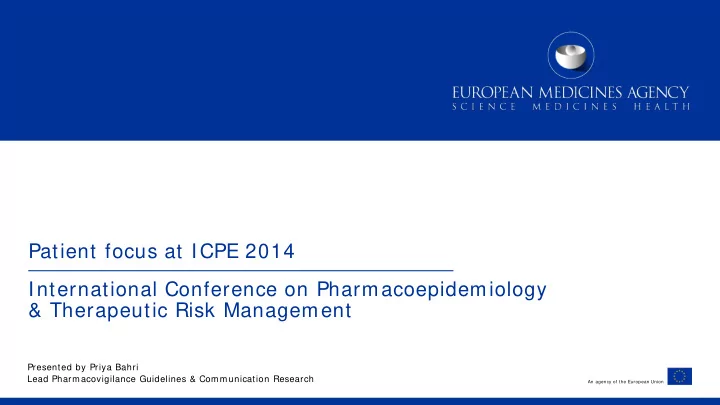

Patient focus at ICPE 2014 International Conference on Pharmacoepidemiology & Therapeutic Risk Management Presented by Priya Bahri Lead Pharmacovigilance Guidelines & Communication Research An agency of the European Union
International Society for Pharmacoepidemiology (ISPE) • Non-profit international professional membership organization • Pharmacoepidemiology = science that applies epidemiologic approaches to studying the use, effectiveness, value and safety of pharmaceuticals. 1 Priya Bahri: ICPE 2014
ICPE 2014 Plenary 2 Priya Bahri: ICPE 2014
“How and why the European Medicines Agency uses patient input during the evaluation of medicines” ICPE 26 October 2014 Nathalie Bere, presented by Priya Bahri European Medicines Agency (EMA) An agency of the European Union
The value of interaction • Increases transparency and builds confidence in the regulatory system • Involvement at operational level leads to tangible im pact on outcomes; – Patients’ views on benefit-risk deliberations contribute to final recom m endations from the committees – Review of product information and safety communications - comments are taken into account and lead to am endm ents • Helps bridge the gap between clinical trial data and real world data; thus improving the outcome of regulatory decisions 4
Input from patients, completes the picture… .. Patient 5
ICPE 2014 Symposium of Special Interest Group BRACE 6 Priya Bahri: ICPE 2014
BRACE cycle 7 Priya Bahri: ICPE 2014
ISPE Symposium 20 October 2014 The Patient’s Voice in the Heart of BRACE - Benefit-Risk Assessment, Communication and Evaluation How patients contribute to assessments at the EMA and messages for pharmacoepidemiology Presented by Priya Bahri Lead Pharmacovigilance Guidelines & Communication Research An agency of the European Union
Combined hormonal contraceptives and VTE Priya Bahri: Patient’s Voice and Pharmacoepidemiology 9
10 Priya Bahri: Patient’s Voice and Pharmacoepidemiology
Combined hormonal contraceptives (CHCs) Referral 2013 - Patient/ consumer involvement • Ad-hoc expert group meeting, including patient/ consumer organisation representation* • Pharmacovigilance Risk Assessment Committee (PRAC) written consultation with patient/ consumer experts* • PRAC has patient/ consumer members • Review by patient representatives of educational materials * Involved organisation: European Institute of Women’s Health 11 Priya Bahri: Patient’s Voice and Pharmacoepidemiology
Ad Hoc Expert Working Group and PRAC written consultation of patient/ consumer experts • Present absolute and relative risk in understandable language, for different age groups and with information on baseline risk and risk changes over time • Preferred options for presenting the information on differential risks (PO: table, HPs: relative and absolute risks in a graph) • For CHCs containing progestogens other than levonorgestrel, include risk for LNG • Preferred options re comparison with VTE risk during pregnancy (PO: no, HPs: helpful) • Stress that actual risk is not large, especially not in young women and that all CHCs are very safe with many non-contraceptive and non-contraceptive benefits • Giving denominator (10, 000) first to see immediately that risk is small (PO) 12 Priya Bahri: ICPE 2014
Internet search on patient perceptions – Example of German patient blog “Risiko-Pille” 13 Priya Bahri: Patient’s Voice and Pharmacoepidemiology
Literature search on patient perceptions – Example of Danish study by Hansen DL in female adolescents 14 Priya Bahri: Patient’s Voice and Pharmacoepidemiology
EMA-procured study: Patterns and Determinants of Use of Oral Contraceptives in the European Union 15 Priya Bahri: Patient’s Voice and Pharmacoepidemiology
How can we inform about differential risk for informed choice and create VTE awareness for risk management without creating a scare? Specific points: - Natural frequencies - Hazard function - Risk factors (or absence) - Comparator 16 Priya Bahri: Patient’s Voice and Pharmacoepidemiology
Messages and questions for pharmacoepidemiology: Important areas for multi-disciplinary BRACE research How can we obtain good data for: • Representative patient values, preferences and risk acceptability in relation to benefit • Utilisation of medicines including differential prescribing and adherence in relation to BR perceptions • Patient-reported outcomes for benefit and risk • Risk expression in natural frequencies with denominators taking into account average length of use and hazard functions • Effectiveness of communication based on combined methods, e.g. survey or media monitoring and medicines utilisation studies 17 Priya Bahri: Patient’s Voice and Pharmacoepidemiology
Thank you for your attention Further information Priya Bahri Lead Pharmacovigilance Guidelines and Communication Research Telephone : + 44-(0)20 3660 8454 Em ail : priya.bahri@ema.europa.eu European Medicines Agency | Office Best Evidence Developm ent Acknowledgements to Nathalie Bere and 30 Churchill Place • Canary Wharf • London E14 5EU • United Kingdom Rebecca Harding, Stakeholder and Communication Follow us on @EMA_ New s Division
Recommend
More recommend